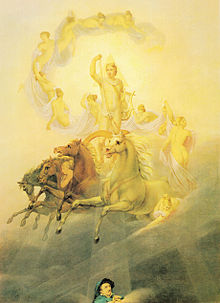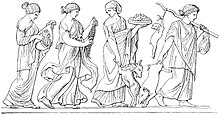Hearing (mythology)
The Horen ( Greek ῟Ωραι , Hōrai , Latinized Horae , "the times", "the seasons") are the goddesses in Greek mythology who supervise the regular life. They are said to have determined and woven a person's life on a loom. The Greek word hōra means "time" or "period"; it can denote a year, a season, a time of day, or an hour.
As daughters of Zeus and Themis, they are goddesses of Greek mythology . They watch over human work in a benevolent manner and, as Homer reports in the Iliad , guard the gates of heaven by pushing the thick clouds away or forward under the roar of thunder. Their names change depending on the source.
First generation
In the Attic they consisted of Thallo , Auxo and Karpo , who were goddesses of the seasons. (The Greeks then only differentiated between spring, summer and winter.) In art they were usually portrayed as young, attractive women, surrounded by brightly colored flowers and lush vegetation or other symbols of fertility . They were especially venerated among the rural population of Greece .
In the most ancient times the Horen are deities of the heavenly cloud water. That is why they are later attributed dewy robes and they also have a well (cloud water) in which they can bathe. The earth owes its colorful spring decorations to them and so they wear flowery clothes themselves. Like the Charites who are close to them, they are also venerated as the goddesses of spring.
Their importance as goddesses of the changing times results from the regular sequence of their gifts and thus the seasons .
- Thallo ( Thalatte , Greek for "bloom") was the goddess of spring, buds and flowers, the flower-bringer and protector of youth.
- Auxo ( Auxesia , Greek for "growth").
- Carpo ( Karpo , Xarpo , Greek for "fruit") ruled over the summer, ripening and harvesting. It protected the roads to Mount Olympus and left the clouds that surrounded his head when one of the gods left him. She was the servant of Persephone , Aphrodite and Hera . She also associated with Dionysus , Apollo and Pan .
Second generation
The second generation in Hesiod's theogony consisted of Eunomia , Dike, and Eirene , who were goddesses of law and order and who maintained the stability of society. They were especially venerated in the cities of Athens , Argos and Olympia .
- Dike (Greek for " justice ") was the goddess of moral justice. She ruled over human justice. She was born mortal and sent to earth by Zeus to keep humanity righteous. Zeus quickly learned that this is impossible and took her to Olympus. She was later elevated to a constellation.
- Eunomia (Greek for “good order”) was the goddess of law and legislation. She (or another goddess of the same name) is also mentioned as the daughter of Hermes and Aphrodite.
- Eirene or Irene (Greek for "peace", Latin Pax ) was the personification of peace and prosperity and was portrayed as a beautiful young woman with the horn of plenty, scepter and a torch or rhyton .
Third generation
Only a few authors mention a third generation of hearing:
- Pherusa or Pherousa, goddess of matter and courts
- Euporia (or Euporia), goddess of abundance
- Orthosia (goddess of wealth)
The 12 hours
Finally there are the 12 (originally only 10) hours, protective goddesses of the different times of the day. The Roman hours were counted from just before sunrise to just after sunset:
- Eye , first light
- Anatole or Anatolia , sunrise
- Mousika or Musica , the morning hour of music and study, not to be confused with the muses
- Gymnastika , Gymnastica or Gymnasia, the morning hour of physical exercise in the Gymnasion
- Nymph , the hour of morning cleansing
- Mesembria , noon
- Sponde , the libations that were shed after lunch
- Elete , prayer, the first of the afternoon working hours
- Akt , Acte, or Cypris , food and pleasure, the second of the afternoon working hours
- Hesperis , evening
- Dysis , sunset
- Arctic , last light
Four groups of ears are distinguished as figures representing the seasons:
- Erinen of Spring
- Xanthene of summer
- Oporines of autumn
- Cheimeria of winter
literature
- Lorenzo Abad Casal: Horai . In: Lexicon Iconographicum Mythologiae Classicae (LIMC). Volume V, Zurich / Munich 1990, pp. 502-510.
- Johannes Andreas Jolles : Horai. In: Paulys Realencyclopadie der classischen Antiquity Science (RE). Volume VIII, 2, Stuttgart 1913, Sp. 2300-2313.
- Theodor Heinze: Horai. In: The New Pauly (DNP). Volume 5, Metzler, Stuttgart 1998, ISBN 3-476-01475-4 , Col. 716 f.
- Vassiliki Machaira: Horai / Horae . In: Lexicon Iconographicum Mythologiae Classicae (LIMC). Volume V, Zurich / Munich 1990, pp. 510-538.
- Adolf Rapp : Horai . In: Wilhelm Heinrich Roscher (Hrsg.): Detailed lexicon of Greek and Roman mythology . Volume 1, 2, Leipzig 1890, Sp. 2712-2731 ( digitized version ).
- Jean Rudhardt : Thémis et les Hôrai. Research on les divinités grecques de la justice et de la paix. Droz, Genève 1999.
Web links
- Horen (seasons) in the Theoi Project (English)
- Listening (times of day) in the Theoi Project (English)

